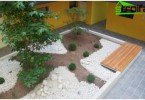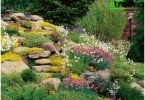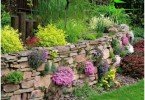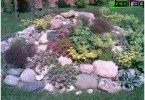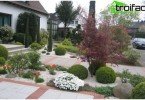A large selection of material for fencing the territory allows you to create an impregnable fortress and an exclusive openwork option, but some gardeners prefer to use trees and shrubs for hedges. And they are right. No modern model of building material can replace the majesty and beauty of wildlife. And with the direct function – protection against penetration – the “green” fence is quite capable of.
Content
- Functions of a live fence
- Great choice for the elite and not only
- How to determine the height of the “fence”
- Landing and maintenance of a live fence
- Important nuances when landing
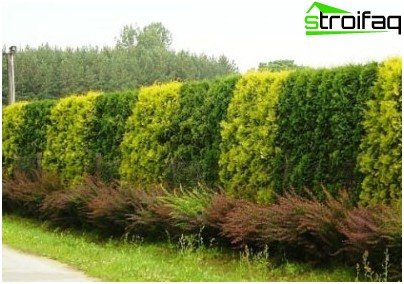
The living “fence” is beautiful and versatile
Functions of a live fence
An innovation should not be considered a hedge; rather, it is a “well-forgotten old”. Landings were used for these purposes in Persia, then Rome, and in Europe they became popular in the Renaissance. With the help of a curly haircut, landscaping was decorated, living labyrinths were created. In modern environmental conditions, such a “fence” is very relevant, because it simultaneously solves many issues.
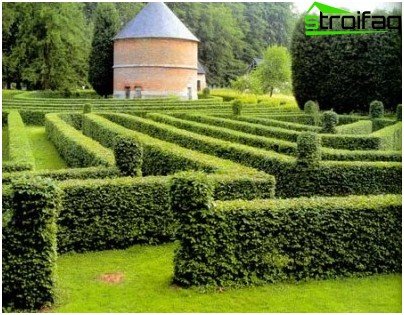
Fashion for hedges came from ancient times
- Protects from intrusions. The most reliable is the impassable landing, through which it will be difficult to get even small field animals.
- Hides unsightly farm buildings, compost heaps, a neighbor’s fence.
- Separate the territory of the playground, recreation areas.
- Helps create exquisite landscape design.
- Filters exhaust gases entering the roadway.
- Protects crops from strong winds and the scorching sun.
- Hides personal territory from prying eyes and noise.
- Creates an atmosphere of peace and tranquility..
Great choice for the elite and not only
It is not difficult to choose plants for the hedge of an elite mansion or a small summer cottage plot. One has only to decide on the purpose for which seedlings are purchased.
The fence can be molded or left in kind. The first option, with proper care, forms a continuous barrier. It is suitable for a small plot or zoning of the territory on a spacious allotment. Freely growing varieties are not so dense, but unpretentious in care. It can be coniferous or flowering shrubs..
Planting climbing plants will hide an unsightly fence. Annuals that grow rapidly (sweet peas, beans, mad cucumber) or herbs with beautiful flowering (delphinium, lupine, mallow) are well suited for decoration..
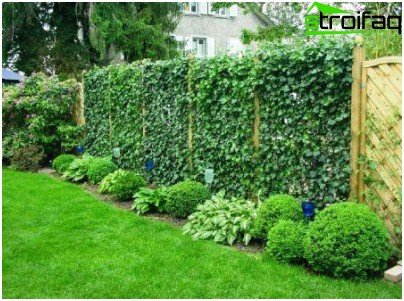
Simple climbing plants will decorate the site and hide personal territory from prying eyes
Luxurious and powerful hedges are creepers. But their heavy green mass can overwhelm a flimsy fence. And from concrete or metal they must be planted at a distance of about 1 m.
Many types of plants are very plastic, and with the help of garden shears you can give them any shape – from a strict geometric to the figure of an animal or a fairy-tale character. Species with a rare crown are not suitable for this. Their branches may break due to wind or snow..
How to determine the height of the “fence”
The height of the hedge is divided into three types.
- High (more than 2 meters)
It performs all functions, including decorative. Best suited for large areas. From coniferous species, you can choose ordinary, prickly, spruce, Canadian, juniper, thawed western, Lavson cypress and pea. They do not lose their attractiveness all year round..
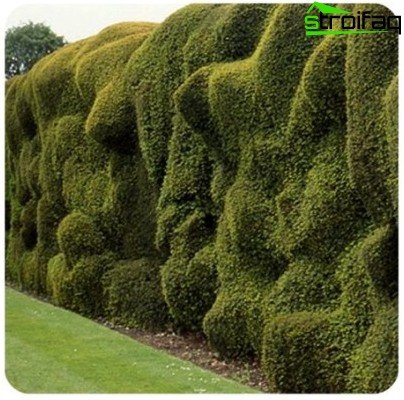
Plants are able to serve as an impregnable fortress
If you live in the country only in the summer, then a hedge of hardwood is quite suitable. Moreover, it changes several times during the season: it blooms, bears fruit, “stains” foliage. These are Tatar maple, small-leaved elm, Siberian hawthorn, Berlin poplar, and small-leaved linden. You need to cut them twice a year. The big advantage of hardwood is its fast growth. In one season, they can form lush thickets in human height..
If molding crowns is not a priority, you can grow a planting from Canadian shrubs or earflowers, Hungarian or ordinary lilacs, Siberian apple trees, common mock orange, viburnum ordinary.
Important! Fast-growing shrubs should be planted in two rows.
- Medium (1-2 meters)
Helps fence off the outside world, protect crops from the wind, hide unsightly buildings. This is currant, barberry, hawthorn, cotoneaster, white derain, spirea, mock, yellow acacia.
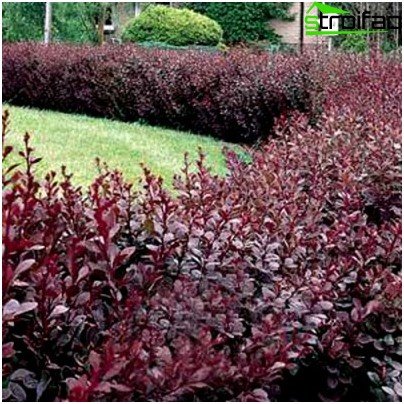
Planting plants of medium height can play a protective and decorative function
From evergreens of medium height, one can distinguish thawed western, Canadian spruce, laurel.
It is interesting! If you alternate coniferous and deciduous varieties, in the winter the fence will become “openwork”. When planting one breed with different colors, the “fence” will always look elegant and festive.
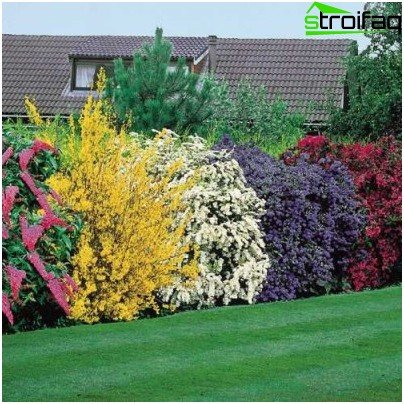
Combining plants allows you to create a unique design
- Undersized (up to 1 meter)
Perform only a decorative function and protect nearby growing flowers and crops from the wind.
Ordinary barberry (purple and green), thuja western, cotoneaster brilliant, currant, and juniper coliform are suitable for the border. There is no need to cut undersized hedges of roses, snowberry, dogrose, Bumald’s spirea.
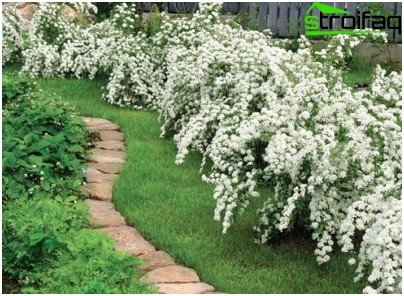
A lively border will decorate paths and flower beds, delimit the territory
The landscape of lavender, boxwood, heather is very beautifully decorated. But it’s important to take into account climate conditions, observe the rules of planting and care, because one dead bush will ruin the whole composition.
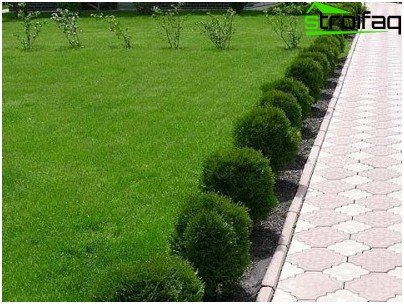
Coniferous and blooming trees look equally beautiful
Landing and maintenance of a live fence
The age of coniferous seedlings should be 3-4 years, deciduous – at least 2. Work should be planned for the autumn period and start with the marking of the territory. If bushes for hedges are planted in one row, the distance between them should be 20-25 cm. Plants with lush foliage and dense roots are suitable for this. With two-row and more planning – 30-50 cm between seedlings, 30-60 cm between rows.
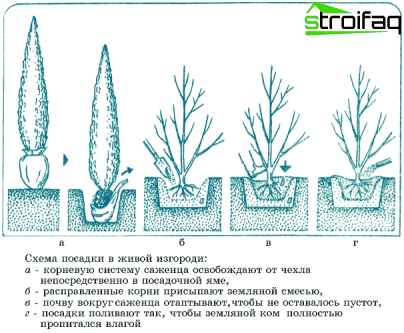
Proper planting ensures the safety and rapid growth of bushes
- The rope is pulled and a long trench is rummaged. Width depends on the number of rows.
- Soil is poured from the top layer to the bottom (this land is more fertile), fertilized with peat, compost or manure.
- Seedlings are deepened so that the neck of the root system is flush with the ground or 1-2 cm lower. Be sure to ensure that the roots are not damaged.
Important! Before planting or in the first year after it, the bushes should be cut to a height of 10 cm. In spring, shoots will appear on them. Leave the strongest, aimed at the plane of the hedge. The rest is cut at an angle of 45 degrees and spliced with the processes of neighboring bushes by grafting. After a few years, a dense impenetrable fence forms. Such a fence must be cut annually.
In the first year, seedlings must be watered, loosened the earth around them. The first pruning is carried out in the fall, in the second year after planting. In summer, bushes can be processed only from the sides, occasionally affecting the top.
It is interesting!
If pruning was nevertheless carried out incorrectly, and the lower part of the plant became “naked” from a lack of lighting, the bushes should be given the appearance of a cone or trapezoid.
In subsequent years, a live fence should be regularly watered and fed, and dry and diseased branches should be removed..
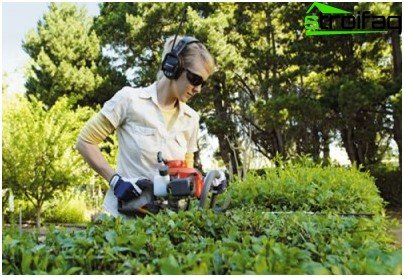
Haircut twice a year
Important nuances when landing
- The soil must be well moistened and well-fed..
- You can not plant bushes too shallow (up to 20 cm in depth).
- Planting should not be near large trees. In a few years, the trunks will be inside her. Such an arrangement is possible only for borders from shade-loving plants (meadowsweet, alpine currant).
- It is necessary to provide good lighting and power supply. Otherwise, the fence will become rare and will not perform its direct functions. Aesthetics will suffer from this too.
- Coniferous plants should not be “fenced” more than in two rows. From the middle it will be difficult to remove dried branches.
Most popular hedge plants
In order not to create big problems for yourself, you should choose plants for hedges that tolerate the climatic conditions of your area, and the soil composition is suitable. For a territory with a temperate continental climate, the choice is wide enough.
- Hawthorn
One of the most unpretentious and easy to take root bushes. In autumn, its foliage is painted in bright green, yellow, red-brown colors, creating a festive mood. The berries are no less beautiful: yellow, orange, red, burgundy and brown.
- Barberry
Well perceives any conditions. It can be used for curbs or hedges. Foliage on one bush can be motley. It blooms beautifully, has healing properties, is used in cooking.
- Yellow acacia
It can create a fence of medium height or reach 5 meters. There are more than 30 species of these plants, so you need to decide for what purpose planting is planned. This is a photophilous shrub that is unpretentious and quickly restored even after hemp haircuts. It blooms beautifully, has lush foliage. Propagated by seeds, therefore, if desired, the hedge can be removed without fear of new growth.
- Cotoneaster
It lends itself well to cutting, quickly recovers after a full cut. A dense crown with shiny dark green leaves in autumn turns red. By the end of summer, it is decorated with beautiful fruits that hold for a long time. There are many varieties from which you can choose deciduous or evergreen..
- Euonymus
It is a real decoration of the site. In summer, it is a dense green crown, which, by autumn, turns into a rainbow of shades from yellow to purple. Blooms in May and June with white and bright pink flowers. The fruits hold until December.
- Boxwood
It is more suitable for the southern regions, but if it is well insulated, it can also take root in the middle lane. There are varieties for borders and a height of up to 3 meters. Has a dense crown and is easy to mold.
- Thuja
The most popular coniferous breed. It has a green color, less often – yellowish. It can be either undersized or up to several meters high. Easy to mold. Moreover, she needs it. Thuja oil is used in medicine and cosmetology.
- Juniper
It can rise to a height of 3 meters. It does not bloom, but year-round reliably protects the territory from the penetration of exhaust gases. Has bactericidal properties.
Important! Evergreen deciduous shrubs do not tolerate our winters.
Hedgerow requires careful care, not only in the first year after planting, but also the rest of the time. She needs trimming, top dressing, but the work brings only joy, allowing the owner to feel like a real artist.


